Anne of Bohemia
| Anne of Bohemia | |
|---|---|
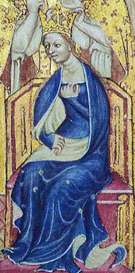 | |
| Queen consort of England | |
| Tenure | 20 January 1382 – 7 June 1394 |
| Coronation | 22 January 1382 |
| Born |
11 May 1366 Prague, Kingdom of Bohemia |
| Died |
7 June 1394 (aged 28) Sheen Palace |
| Burial | Westminster Abbey, London |
| Spouse | Richard II of England |
| House | House of Luxembourg |
| Father | Charles IV, Holy Roman Emperor |
| Mother | Elizabeth of Pomerania |
Anne of Bohemia (11 May 1366 – 7 June 1394) was Queen of England as the first wife of King Richard II. A member of the House of Luxembourg, she was the eldest daughter of Charles IV, Holy Roman Emperor and King of Bohemia, and Elizabeth of Pomerania.[1] She died at 28 after 12 years of marriage; she was childless, and greatly mourned by her husband.
The marriage was initially unpopular in England inasmuch as, even though Anne's father was perhaps the most powerful monarch in Europe, his relatively distant area of influence could give little trade or political advantage to England, and Anne brought no dowry; instead Richard had to pay her brother a sum. But Anne appears to have won many English people over with her personality, and her efforts to help obtain royal pardons.
Her father's court, based in Prague, was a centre of the International Gothic style, then at its height, and her arrival seems to coincide with, and probably caused, new influences on English art. The Crown of Princess Blanche, now in Munich, may have been made for Anne, either in Prague or Paris.[2]
She had four brothers, including Sigismund, Holy Roman Emperor, and one younger sister, Margaret of Bohemia, Burgravine of Nuremberg. She also had five half-siblings from her father's previous marriages. Anne is buried in Westminster Abbey beside her husband.
Marriage to King Richard II of England
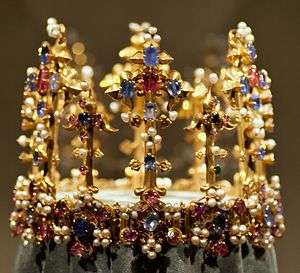
Richard II married Anne of Bohemia as a result of the Western Schism in the Papacy that had resulted in two rival popes. According to Eduard Perroy, Pope Urban VI actually sanctioned the marriage between Richard and Anne, in an attempt to create an alliance on his behalf, particularly so that he might be stronger against the French and their preferred pope, Clement.[3] Anne's father was the most powerful monarch in Europe at the time, ruling over about half of Europe's population and territory.[4]
The marriage was against the wishes of many members of his nobility and members of parliament, and occurred primarily at the instigation of Richard's intimate, Michael de la Pole. Although Richard had been offered Caterina Visconti, one of the daughters of Bernabò Visconti of Milan, who would have brought a great deal of money with her as dowry, Anne was chosen – bringing no direct financial benefits to England. She brought with her no dowry, and in return for her hand in marriage, Richard gave 20,000 florins (around £4,000,000 in today's value) in payment to her brother Wenceslas. There were also only a few diplomatic benefits – although English merchants were now allowed to trade freely within both Bohemian lands, and lands of the Holy Roman Empire, this was not much when compared to the usual diplomatic benefits from marriages made as a result of the war with France. It is therefore no surprise that the marriage was unpopular.
On her arrival in December 1381, Anne was severely criticised by contemporary chroniclers, probably as a result of the financial arrangements of the marriage, although it was quite typical for queens to be viewed in critical terms. The Westminster Chronicler called her "a tiny scrap of humanity",[5] and Thomas Walsingham related a disastrous omen upon her arrival, where her ships smashed to pieces as soon as she had disembarked.[6] Nevertheless, Anne and King Richard II were married in Westminster Abbey on 20 January 1382. Tournaments were held for several days after the ceremony, in celebration. They then made a tour of the realm, staying at many major abbeys along the way. In 1383 Anne of Bohemia visited the city of Norwich, where at the Great Hospital a ceiling comprising 252 black eagles was made in her honour.[7]
Anne's wedding to Richard II was the fifth royal wedding in Westminster Abbey and was not followed by any other royal wedding in Westminster Abbey for another 537 years.[8]
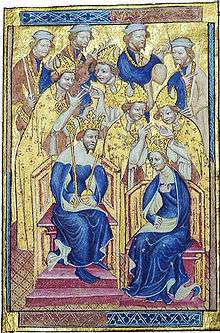
They were married for 12 years, but had no children. Anne's death from plague in 1394 at Shene Manor was a devastating blow to Richard. Historians have speculated that her counsel had a moderating effect on Richard during her lifetime.[9] This is supported by his unwise conduct in the years after Anne's death that lost him his throne.[10]
Richard married his second wife, Isabella of Valois, on 31 October 1396.
Reputation
Although Anne was originally disliked by the chroniclers, there is some evidence that she became more popular in time. She was a very kind person and popular with the people of England; for example, she was well known for her tireless attempts to "intercede" on behalf of the people, procuring pardons for participants in the Peasants' Revolt of 1381, and numerous other pardons for wrongdoers.
She also made several high-profile intercessions in front of the king. Anne saved the life of John Northampton, a former mayor of London, in 1384; her humble begging convinced Richard II to merely commit the offender to lifelong imprisonment.[11] Anne's most famous act of intercession was on behalf of the citizens of London in the ceremonial reconciliation of Richard and London in 1392. The queen's role has been memorialized in Richard Maidstone's Reconciliation of Richard II with the City of London.[12]
Anne also interceded on behalf of Simon Burley, Richard II's former tutor during his minority, in the 1388 Merciless Parliament. Despite her pleas to the Appellants, Burley was executed.[13]
On the other hand, she never fulfilled many traditional duties of queens. In particular, she did not bear children, despite twelve years of marriage, and this is perhaps emphasised in her epitaph, whereby she is mentioned as having been kind to "pregnant women". The Evesham chronicler said, "this queen, although she did not bear children, was still held to have contributed to the glory and wealth of the realm, as far as she was able. Noble and common people suffered greatly at her death".[14] Nevertheless, her popular legacy as "Good Queen Anne" suggests that this lack of children was unimportant to many contemporaries.
Legacy
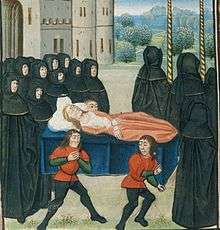
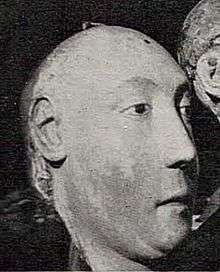
Anne is buried in Westminster Abbey beside her husband. Their joint tomb, now damaged, once showed their clasping hands. The inscription on her tomb describes her as "beauteous in body and her face was gentle and pretty." When her tomb was opened in 1871, it was discovered that many of her bones had been stolen via a hole in the side of the casket.[15]
Anne of Bohemia is known to have made the sidesaddle more popular to ladies of the Middle Ages. She also influenced the design of carts in England when she arrived in a carriage, presumably from Kocs, Hungary, to meet her future husband Richard (the name of Kocs is considered to have given rise to the English word coach). She also made the horned, Bohemian-style headdress the fashion for Englishwomen in the late 14th century.
Arms
 |
|
Ancestry
| Ancestors of Anne of Bohemia | ||||||||||||||||||||||||||||||||||||||||||||||||||||||||||||||||||||||||||||||||||||||||||||||||||||||||||||||||||||||||||||||||||||||||||||||||||||||||||||||||||||||||||||||||||||||||||||||||||||||||||||||||||||||||||||||||||||||||||||||||||||||||||||||||||||||||||||||||||||||||||||||||||||||||||||||||||||||||||||||||||||||||||||||||||||||||||||||||||||||||||||||||||||||||||||||||||||||||||||||||||||||||||||||||||||||||||||||||||||||||||||||||||||||||||||||||||||||||||||||||||||||||||||||||||||||||||||||||||
|---|---|---|---|---|---|---|---|---|---|---|---|---|---|---|---|---|---|---|---|---|---|---|---|---|---|---|---|---|---|---|---|---|---|---|---|---|---|---|---|---|---|---|---|---|---|---|---|---|---|---|---|---|---|---|---|---|---|---|---|---|---|---|---|---|---|---|---|---|---|---|---|---|---|---|---|---|---|---|---|---|---|---|---|---|---|---|---|---|---|---|---|---|---|---|---|---|---|---|---|---|---|---|---|---|---|---|---|---|---|---|---|---|---|---|---|---|---|---|---|---|---|---|---|---|---|---|---|---|---|---|---|---|---|---|---|---|---|---|---|---|---|---|---|---|---|---|---|---|---|---|---|---|---|---|---|---|---|---|---|---|---|---|---|---|---|---|---|---|---|---|---|---|---|---|---|---|---|---|---|---|---|---|---|---|---|---|---|---|---|---|---|---|---|---|---|---|---|---|---|---|---|---|---|---|---|---|---|---|---|---|---|---|---|---|---|---|---|---|---|---|---|---|---|---|---|---|---|---|---|---|---|---|---|---|---|---|---|---|---|---|---|---|---|---|---|---|---|---|---|---|---|---|---|---|---|---|---|---|---|---|---|---|---|---|---|---|---|---|---|---|---|---|---|---|---|---|---|---|---|---|---|---|---|---|---|---|---|---|---|---|---|---|---|---|---|---|---|---|---|---|---|---|---|---|---|---|---|---|---|---|---|---|---|---|---|---|---|---|---|---|---|---|---|---|---|---|---|---|---|---|---|---|---|---|---|---|---|---|---|---|---|---|---|---|---|---|---|---|---|---|---|---|---|---|---|---|---|---|---|---|---|---|---|---|---|---|---|---|---|---|---|---|---|---|---|---|---|---|---|---|---|---|---|---|---|---|---|---|---|---|---|---|---|---|---|---|---|---|---|---|---|---|---|---|---|---|---|---|---|---|---|---|---|---|---|---|---|---|---|---|---|---|---|---|---|---|---|---|---|---|---|---|---|---|---|---|---|---|---|---|---|---|---|---|---|---|---|---|---|---|---|---|---|---|---|---|---|---|---|---|---|---|---|---|---|---|---|---|---|---|---|---|---|---|---|---|---|---|---|---|---|---|---|---|---|---|---|---|---|---|---|---|---|---|---|---|---|---|---|---|---|---|---|---|---|---|---|---|---|---|---|---|---|---|
| ||||||||||||||||||||||||||||||||||||||||||||||||||||||||||||||||||||||||||||||||||||||||||||||||||||||||||||||||||||||||||||||||||||||||||||||||||||||||||||||||||||||||||||||||||||||||||||||||||||||||||||||||||||||||||||||||||||||||||||||||||||||||||||||||||||||||||||||||||||||||||||||||||||||||||||||||||||||||||||||||||||||||||||||||||||||||||||||||||||||||||||||||||||||||||||||||||||||||||||||||||||||||||||||||||||||||||||||||||||||||||||||||||||||||||||||||||||||||||||||||||||||||||||||||||||||||||||||||||
References
- ↑ Strickland, Agnes, Lives of the Queens of England from the Norman Conquest, (Lea & Strickland, 1841), 303, 308.
- ↑ Cherry, John, in: Jonathan Alexander & Paul Binski (eds), Age of Chivalry, Art in Plantagenet England, 1200–1400, Catalogue number 16, Royal Academy/Weidenfeld & Nicholson, London 1987
- ↑ citation needed
- ↑ Westminster Abbey
- ↑ Westminster Chronicle 1381-1394, edited by L.C. Hector and B.F. Harvey (Oxford: Clarendon Press, 1982), 25.
- ↑ Thomas Walsingham, The St Albans Chronicle: The Chronica Maiora of Thomas Walsingham, Vol I: 1376-1394, ed. and trans. by John Taylor, Wendy R. Childs, and Leslie Watkiss (Oxford: Clarendon Press, 2003), 572-575.
- ↑ http://www.greathospital.org.uk/history.shtml. and Carole Rawcliffe, Medicine for the Soul: The Life, Death and Resurrection of an English Medieval Hospital St. Giles’s, Norwich, c.1249-1550 (Stroud: Sutton Publishing, 1999), 118 and notes to plate 7
- ↑ "HRH Prince William of Wales and Miss Catherine Middleton to Wed at Abbey Archived 26 March 2011 at the Wayback Machine.".
- ↑ Costain, Thomas (1962). The Last Plantagenets. Garden City, NY: Doubleday. pp. 148, 149, 153. ISBN 978-1568493732.
- ↑ Strickland, 323–324.
- ↑ Westminster Chronicle 1381-1394, edited by L.C. Hector and B.F. Harvey (Oxford: Clarendon Press, 1982), 93.
- ↑ Richard Maidstone, Concordia (The Reconciliation of Richard II with London), ed. by David R. Carlson and trans. by A.G. Rigg (Kalamazoo: Medieval Institute Publications, 2003). Available online at http://www.lib.rochester.edu/camelot/teams/maidfrm.htm.
- ↑ Some chronicles record that Anne knelt before the earl of Arundel, while others indicate Thomas of Woodstock, duke of Gloucester. For Arundel, see: Chronique de la traïson et mort de Richart Deux roy D'Engleterre, ed. by Benjamin William (London : Aux dépens de la Société, 1846), 133; The Kirkstall Abbey Chronicles, ed. by John Taylor (Leeds: The Thoresby Society, 1952), 71; An English Chronicle, 1377-1461: edited from Aberystwyth, National Library of Wales MS 21068 and Oxford, Bodleian Library MS Lyell 34, ed. by William Marx (Woodbridge: Boydell Press, 2003), 11. For Gloucester, see: Eulogium Historiarum (continuation), ed. by Frank Scott Haydon, Vol. III (London: Longman, Green, Longman, Roberts, and Green, 1863), 372; An English chronicle, 1377-1461, 16-7 suggests Anne knelt to both men.
- ↑ Historia Vitae et Regni Ricardi II, ed. by G.B. Stow (Philadelphia: University of Pennsylvania Press, 1977), 134.
- ↑ Richard II and Anne of Bohemia Archived 13 May 2008 at the Wayback Machine. at Westminster-Abbey.org. Accessed 11 March 2008.
- ↑ Boutell, Charles (1863), A Manual of Heraldry, Historical and Popular, London: Winsor & Newton, p. 276
External links
| Wikimedia Commons has media related to Anne of Bohemia. |
- Images of Anne of Bohemia at the National Portrait Gallery
- Bronze Effigy of Anne of Bohemia on Westminster Tomb
| English royalty | ||
|---|---|---|
| Vacant Title last held by Philippa of Hainault |
Queen consort of England Lady of Ireland 22 January 1383 – 7 June 1394 |
Vacant Title next held by Isabella of Valois |
.svg.png)